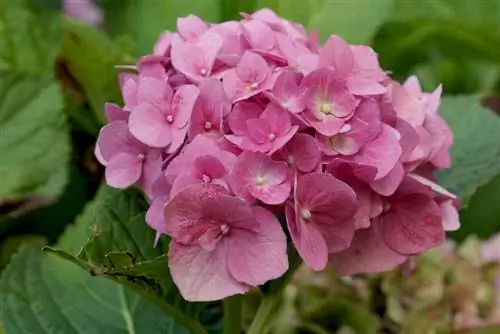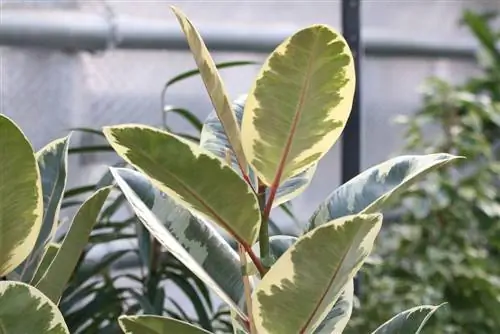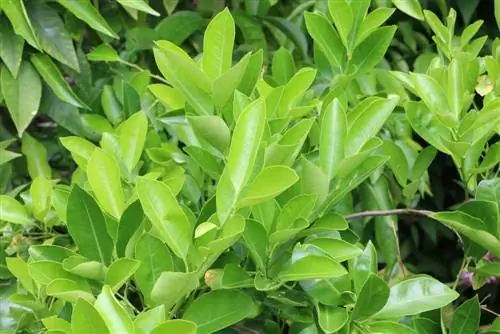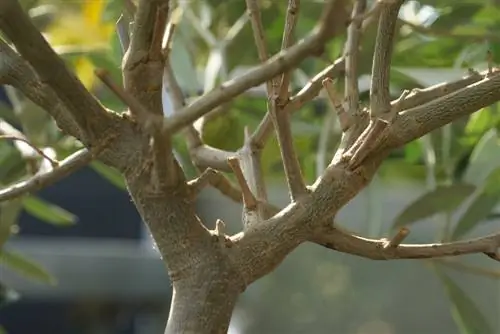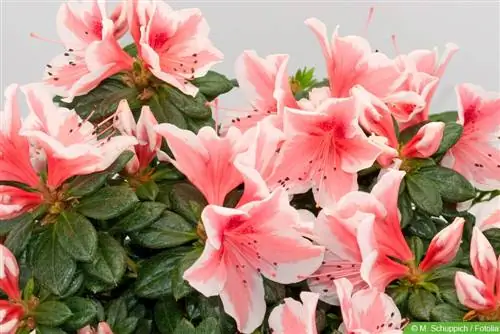- Author admin [email protected].
- Public 2023-12-17 03:39.
- Last modified 2025-06-01 06:48.
Hydrangeas are the flower-filled focal points in many gardens. The flowers shine in many shades - from white to delicate pink and intense pink to blue - and attract many eyes. They also bring colorful variety to the garden or balcony. If hydrangeas shed leaves and flowers, they quickly become a sad sight. However, with the right countermeasures, the underlying causes can usually be remedied quite easily.
Substrate
Hydrangeas have very high demands when it comes to the substrate. It has to be loose and fibrous, but also able to store water well and not become compacted or waterlogged. To do this, the plants need an acidic pH value of 4 to 5.5 - depending on the flower color.
If the hydrangea drops leaves and flowers, the first thing to think about is a problem with the substrate. We recommend:
- to test the pH value
- check the condition
- If necessary, change the soil
Regular repotting is urgently needed, especially when growing in containers. The hydrangeas should not be left in the same soil for longer than two years.
Tip:
If you are unsure about the choice of substrate or mixture, you can use special soil for hydrangeas and azaleas from specialist retailers. This meets all the requirements of the plants.
drought
Hydrangeas need a lot of water. Regular watering is particularly important during the growth phase and especially during the flowering period. If the leaves hang, look limp and wilted, the substrate should be checked. Only the top layer should be dried out and crumbly.
The soil should then appear moist. This cause of loss of leaves and flowers is very easy to remedy, as you simply need to water more. If dryness occurs again and again, a few simple tips can prove useful:
- switch to a substrate that retains moisture better
- Apply bark mulch to the soil
- Cover the substrate with stones or garden foil
These measures reduce evaporation and keep the soil moist for longer. If you then water thoroughly so that the substrate can soak up properly, drying out and thus the loss of leaves and flowers can be prevented.
Lime
Hydrangeas like a slightly acidic substrate and should therefore only be watered with soft - i.e. low-lime - water. Rainwater and stale tap water are ideal. If this has not been taken into account, the plant can also drop leaves and flowers.
The appropriate countermeasures consist of changing the substrate and using rainwater in the future. If changing the substrate is difficult, acidifying fertilizers can also be used. For heavy, compacted soils, sulfur and iron sulfate can be used. Coffee grounds are also suitable for slightly acidifying the substrate.
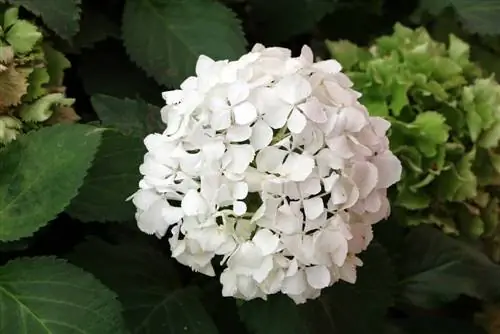
In loose soils, more organic products can be used. Compost and rotted oak leaves are particularly suitable. During these measures, the pH value of the soil should be measured repeatedly to check success and avoid acidification. It is also important to work the chosen agent evenly and thoroughly onto the surface of the substrate and then water it well.
Wetness
Hortensas need a lot of water, but the plants cannot tolerate waterlogging. Care should therefore be taken very carefully to ensure that the plant is not standing in water in the pot. When planted freely in the garden, control becomes a little more difficult. However, a small excavation can provide information.
With soil that tends to compact and substrate components that can store a lot of liquid, it's not just watering that should be suspended. Additional loosening material should be introduced here. Recommended items include:
- Quartz sand, this improves water drainage
- Coconut soil
- Perlite
- Sand
How much of it needs to be added depends on the initial state of the substrate. It can also make sense to add a drainage layer made of pottery shards in the bucket.
Nutrient Deficiency
If a nutrient deficiency is responsible for the shedding of leaves and flowers, this is usually due to an undersupply of iron or nitrogen. However, both are relatively easy to identify and fix.
Nitrogen deficiency
When there is a nitrogen deficiency, the older leaves turn yellow first. This means that the plant yellows from the bottom up and from the inside out. A fertilizer containing nitrogen can help here. However, if it is added to the substrate, compensation can take several weeks. It is therefore particularly suitable when yellowing and leaf drop have not yet progressed too far.
However, if things have to be done quickly because the plant is already suffering significant losses, a foliar fertilizer should be used. In this form, the nutrients are absorbed in a significantly shorter time because they do not have to take the “detour” via the roots.
Iron deficiency
Yellowing of the leaves is also typical of iron deficiency. However, the leaf veins are still green. This condition is called chlorosis. Following the discoloration, the hydrangea sheds leaves and flowers. Here too you should act quickly.
Suitable antidotes are:
- Iron chelate
- Iron fertilizer
- Blood Meal
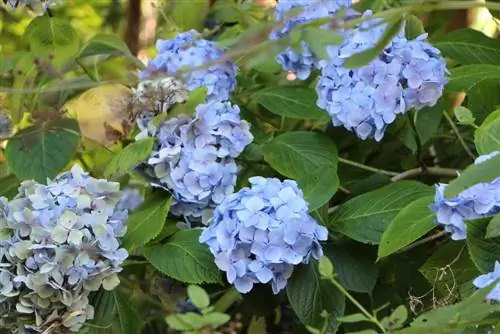
In addition, if there are signs of iron deficiency, you should make sure that the pH value of the substrate is in the acidic range. Otherwise, the absorption of nutrients and minerals may be difficult.
Fertilization
Apart from the deficiencies mentioned, the hydrangea can also be generally under-supplied. The right fertilization can help here. It is particularly easy to use special hydrangea fertilizer. The manufacturer's instructions should be followed. In container culture, part of the nutrient supply can also be ensured through regular substrate changes. Replacing it every one to two years is ideal. If the soil is of poor quality, it should be changed every year.
Pests and diseases
In hydrangeas, spider mites and the leaf spot fungus are primarily responsible for the shedding of flowers and leaves. In both infestations, the leaves become mottled and eventually brown before falling off. In addition, the plant is generally weakened, so that flower loss is foreseeable. Here too, it makes sense to take quick action against the infestation in order to limit the damage to the hydrangea and also prevent the fungi and pests from spreading to other plants.
Spider mites
The leaves turn brown and often curl up. Greasy streaks and woven webs are visible. An infestation with spider mites is relatively easy to recognize if you look closely. Fighting it is not that easy and requires a little more effort. The affected leaves should be cut off or collected and destroyed or disposed of with household waste. To prevent further damage, appropriate measures should be used immediately.
Spider mites are among the most difficult parasites to combat - so the destruction of the leaves and the use of the chosen agents must be comprehensive and thorough. It also helps to check the culture conditions. The spider mites like it dry and warm. In very dry locations, occasional spraying has a preventive effect.
Leaf spot fungus
The same procedure should be followed for leaf spot fungus as for spider mites. Infected leaves must be destroyed to prevent further spread. Leaves that have already fallen should also be collected and disposed of accordingly.
A fungicide must also be used. It also helps to check the location for suitability. If the hydrangea is in a very humid environment and particularly calm, the mushrooms have an easy time.
Cold
Frostbite is not uncommon with hydrangeas. If shoots were exposed to sub-zero temperatures, they not only shed leaves but also died completely. Exceptions here are particularly frost-hardy varieties, such as individual panicle hydrangeas - these can easily tolerate temperatures as low as -30 °C. For everyone else, frost protection made from brushwood, straw and garden fleece or bringing it into the house is mandatory.
Prevention
If deciduous hydrangeas drop leaves and flowers outside of autumn, this is always an indication that care is not optimal. In any case, it makes sense to check all influences and adjust them if necessary. The following points can help:
- Check location for suitability, neither too dry nor too humid
- Examine substrate and test pH value
- Control moisture of the substrate
- regular visual inspections of the plants
- use low-lime water
- fertilize regularly
- When growing in containers, change the substrate at least every two years
Conclusion
When hydrangeas drop leaves and flowers, you need to act quickly. Although the causes are usually relatively harmless, they still require appropriate countermeasures. The best prevention is to strengthen the plants through optimal cultivation conditions.

